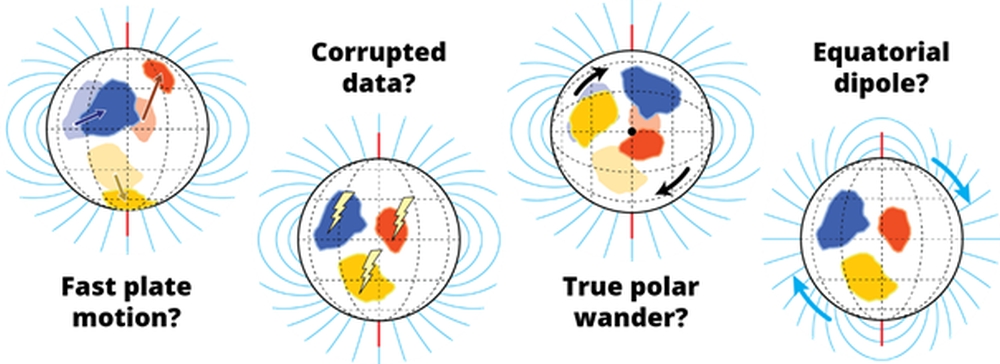About the project
The Ediacaran Period (~635-539 million years ago) was an interval of immense global change. The beginning of the Ediacaran marked the end of protracted, global-scale glaciations (‘Snowball Earth’) and the end of the period coincided with a major biological diversification event (the Cambrian ‘radiation’). In between, the Ediacaran witnessed the largest carbon isotopic swings in Earth history, possibly the rise of atmospheric oxygen to modern levels, and the final breakup of one supercontinent (Rodinia) and the assembly of another (Gondwana).
Given the immensity of those changes, great efforts have been dedicated to better resolve them in time, but we still lack the ability to reconstruct and study them in space, which precludes an understanding of the processes behind them. Normally, we can determine paleogeography by studying records of the ancient geomagnetic field (preserved in rocks), which hold information about the past positions of continents. However, Ediacaran paleomagnetic data appear unusually complex and often contradictory—and until we know the nature of their enigmatic behavior we cannot resolve Ediacaran paleogeography.
Four alternative hypotheses have been proposed to explain the enigmatic Ediacaran paleomagnetic data: 1) the tectonic plates were moving especially fast, 2) many of the paleomagnetic data have been corrupted, 3) the solid Earth tipped rapidly in response to mass distribution changes (‘true polar wander’), or 4) the geomagnetic field was behaving abnormally.
Each of these hypotheses has far-reaching implications for the Earth sciences. EPIC will conduct tests of each of these hypotheses through the collection of new observational and experimental data from Ediacaran sections around the globe. This will ultimately unlock a framework with which we can reconstruct and understand the dramatic biologic, geochemical and climatic changes that were occurring on Earth at this critical time.

Objectives
The objective of EPIC is to determine the nature of the enigmatic Ediacaran paleomagnetic records to allow the reconstruction of global paleogeography at this critical time in Earth history. EPIC will seek to achieve this through the completion of several tasks:
1. Resolve the rate and spatial pattern of Ediacaran paleomagnetic directional changes. The four hypotheses make different predictions for how paleomagnetic directions should evolve through time and space, but well-dated, high-resolution records are needed to discriminate between them.
2. Determine the strength and stability of the Ediacaran magnetic field. Both the intensity and the stability of the geomagnetic field appear to have been abnormal during the Ediacaran, but there are not yet enough constraints to understand its nature or its relationship to the enigmatic paleomagnetic directional record.
3. Evaluate the fidelity of Ediacaran magnetization carriers. The possibility that many of the existing data are corrupted in ways that have not yet been recognized mandates a closer scrutiny of the magnetization carriers with non-conventional approaches.
4. Execution of hypothesis tests. Through the combined analysis of new paleomagnetic, geochronologic and rock magnetic analyses on Ediacaran units from across the globe, EPIC will conduct direct tests of each of the alternative hypotheses to identify the nature of the paleomagnetic changes.
5. Paleogeographic reconstruction. Once the paleomagnetic signals are deciphered, they will be applied to build a robust Ediacaran paleogeographic framework that can be used to spatially restore and study environmental and biologic records from this dynamic period.
Financing
The full name of the research project is 'Untangling Ediacaran Paleomagnetism to Contextualize Immense Global Change'. The project is funded by the European Union as a ERC Consolidator grant, EPIC; project number 101043844, and is granted to Mathew Domeier.
The project period is from October 2022 to September 2027.
Cooperation
The research in EPIC is carried out by researchers at the Department of Geosciences and the CEED-Centre, both University of Oslo. The research is done in cooperation with researchers from several research institutions as mentioned below:
- Geological Survey of Norway, NGU
- University of Bergen
- Utrecht University
- University of Liverpool
- Institut de Physique de Globe de Paris
- São Paulo State University
- University of Florida
- Yale University
- University of Texas at Austin
Disclaimer: “Funded by the European Union. Views and opinions expressed are however those of the author(s) only and do not necessarily reflect those of the European Union or [name of the granting authority]. Neither the European Union nor the granting authority can be held responsible for them.”


